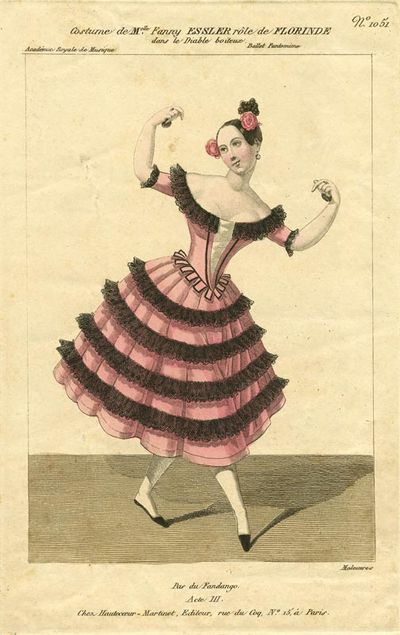Annotation:Fanny Elssler's Hornpipe: Difference between revisions
(Created page with "__NOABC__ <div class="noprint"> =='''Back to [[{{BASEPAGENAME}}]]'''== </div> ---- {{#lst:{{PAGENAME}}|abc}} ---- <div style="page-break-before:always"></div> <p><font face="C...") |
m (Text replacement - "<div style="text-align: justify; direction: ltr; margin-bottom: 90px; margin-left: 70px; margin-right: 120px;">" to "<div style="text-align: justify;">") |
||
| (5 intermediate revisions by 2 users not shown) | |||
| Line 7: | Line 7: | ||
---- | ---- | ||
<div style="page-break-before:always"></div> | <div style="page-break-before:always"></div> | ||
<p><font face=" | <p><font face="sans-serif" size="2"> | ||
<div style="text-align: justify | <div style="text-align: justify;"> | ||
<br> | <br> | ||
[[File:ellsler.jpg|400px|thumb|right|Fanny Ellsler as Florinda in the dance La Cachucha from the 1836 Coralli/Gide ballet Le Diable boiteux. Paris, 1836]] | |||
'''FANNY ELSSLER'S HORNPIPE.''' American, Hornpipe (2/4 time). F Major. Standard tuning (fiddle). AABB. Austrian dancer Fanny Elssler [https://en.wikipedia.org/wiki/Fanny_Elssler] (1810-1884) left the Paris Opera between 1840 and 1842 to tour the United States, performing in Boston, Philadelphia, New York, New Orleans, St. Louis as well as Havana. The theatrical news weekly '''The Spirit of the Times''' wrote that watching Elssler dance "was something to increase our enjoyment of life on the stage, to elevate and idealize the beauty of girlhood, the movements of the form in happy natural woman, by marrying them to music and dance." | '''FANNY ELSSLER'S HORNPIPE.''' American, Hornpipe (2/4 time). F Major. Standard tuning (fiddle). AABB. Austrian dancer Fanny Elssler [https://en.wikipedia.org/wiki/Fanny_Elssler] (1810-1884) left the Paris Opera between 1840 and 1842 to tour the United States, performing in Boston, Philadelphia, New York, New Orleans, St. Louis as well as Havana. The theatrical news weekly '''The Spirit of the Times''' wrote that watching Elssler dance "was something to increase our enjoyment of life on the stage, to elevate and idealize the beauty of girlhood, the movements of the form in happy natural woman, by marrying them to music and dance." | ||
<br> | |||
<br> | |||
During the following five years Fanny appeared in Germany, Austria, France, England, and Russia. In 1845, having amassed a fortune, she retired from the stage and settled near Hamburg. | |||
<br> | <br> | ||
</div> | </div> | ||
| Line 16: | Line 20: | ||
<div class="noprint"> | <div class="noprint"> | ||
== Additional notes == | == Additional notes == | ||
<p><font face=" | <p><font face="sans-serif" size="2"> | ||
<font color=red>''Source for notated version''</font>: - | <font color=red>''Source for notated version''</font>: - | ||
<br> | <br> | ||
<br> | <br> | ||
</font></p> | </font></p> | ||
<p><font face=" | <p><font face="sans-serif" size="2"> | ||
<font color=red>''Printed sources''</font> : - Oliver Ditson ('''The Boston Collection of Instrumental Music'''), c. 1850; p. 59. | <font color=red>''Printed sources''</font> : - Oliver Ditson ('''The Boston Collection of Instrumental Music'''), c. 1850; p. 59. | ||
<br> | <br> | ||
<br> | <br> | ||
</font></p> | </font></p> | ||
<p><font face=" | <p><font face="sans-serif" size="2"> | ||
<font color=red>''Recorded sources'': </font> <font color=teal> - </font> | <font color=red>''Recorded sources'': </font> <font color=teal> - </font> | ||
</font></p> | </font></p> | ||
Latest revision as of 20:19, 11 June 2019
X:1 % T:Fanny Elssler's Hornpipe M:2/4 L:1/8 B:Oliver Ditson – The Boston Collection of Instrumental Music (c. 1850, p. 59) Z:AK/Fiddler’s Companion K:F f/g/|a/g/f/e/ g/f/e/d/|c/d/c/=B/ c/d/e/f/|c/d/c/=B/ c/d/e/f/|g/a/^f/a/ g=f/g/| a/g/f/e/ g/f/e/d/|c/d/c/=B/ c/d/e/f/|d/e/f/g/ e/f/g/a/|f/c/a/g/ f!fermata!:| f/g/|(a/f/).f/.f/ (g/e/).e/.e/|(f/d/).d/.d/ (e/^c/).c/.c/|d/A/g/e/ d/e/f/d/|e/A/a/A/ ef/g/| (a/f/).f/.f/ (g/e/).e/.e/|(f/d/).d/.d/ (e/^c/).c/.c/|d/A/d/f/ a/g/e/f/|d/A/f/e/ d!D.C.!:|]

FANNY ELSSLER'S HORNPIPE. American, Hornpipe (2/4 time). F Major. Standard tuning (fiddle). AABB. Austrian dancer Fanny Elssler [1] (1810-1884) left the Paris Opera between 1840 and 1842 to tour the United States, performing in Boston, Philadelphia, New York, New Orleans, St. Louis as well as Havana. The theatrical news weekly The Spirit of the Times wrote that watching Elssler dance "was something to increase our enjoyment of life on the stage, to elevate and idealize the beauty of girlhood, the movements of the form in happy natural woman, by marrying them to music and dance."
During the following five years Fanny appeared in Germany, Austria, France, England, and Russia. In 1845, having amassed a fortune, she retired from the stage and settled near Hamburg.
